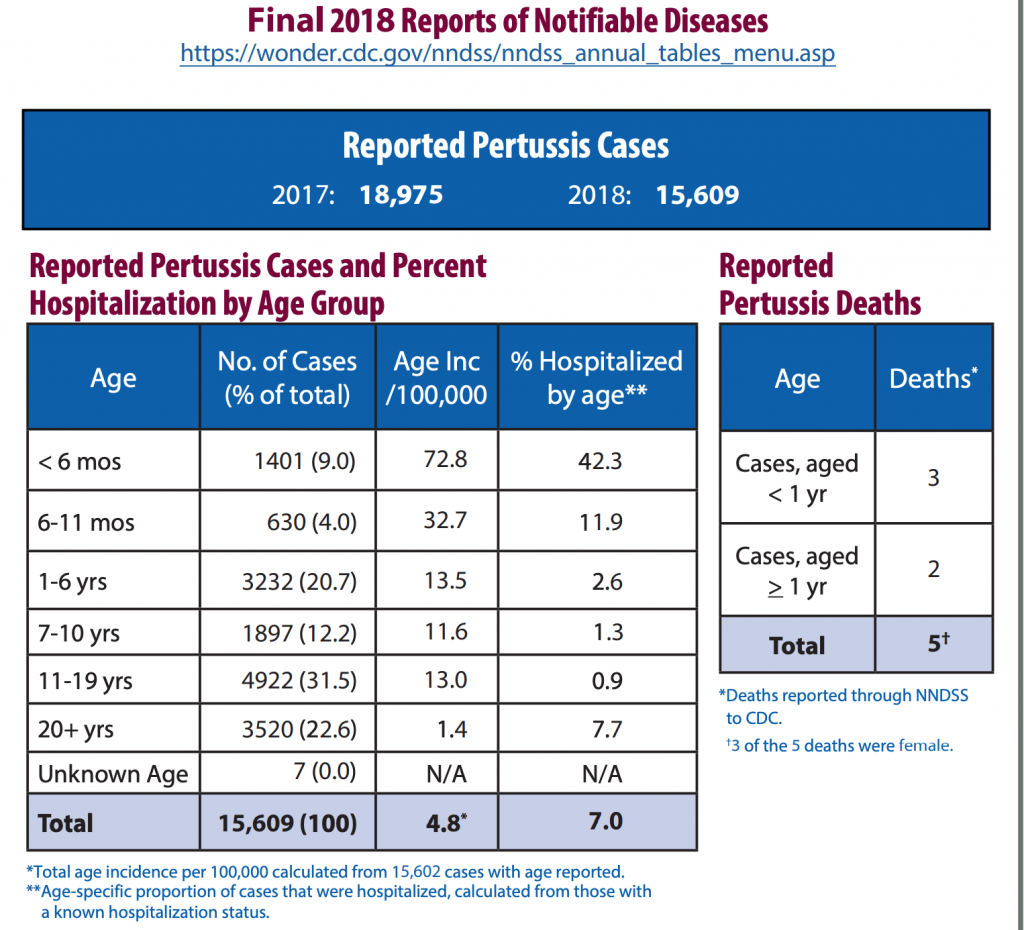Yay! You have made it to part 3! Hopefully you found parts 1 & 2 really interesting. We are at the last part of DTaP: acellular Pertussis. As a recap, DTaP is recommended according to the CDC’s schedule at: 2mo, 4mo, 6mo, 15mo & 5 years, 11years, then every 10 years after that, and every pregnancy (regardless of when you had it last.). So how many cases of pertussis (whooping cough) are there each year in the US and how many deaths from it?
What is pertussis? From the CDC, “Pertussis, more commonly known as whooping cough, is a contagious, respiratory disease caused by the bacterium Bordetella pertussis. The illness is typically characterized by a prolonged paroxysmal cough that is often accompanied by an inspiratory whoop. Disease presentation can vary with age and history of previous exposure or vaccination. Young infants may present to a clinic or hospital with apnea and no other disease symptoms. Adults and adolescents with some immunity may exhibit only mild symptoms or have the typical prolonged paroxysmal cough. In all persons, cough can continue for months.” (cdc.gov/vaccines)
So how many cases are there each year in the US? This is a great chart if you want to see each year how many cases of pertussis there are in the US Pertussis Cases Per Year Chart
How many deaths are there in the US each year from pertussis? Checkout this chart from the cdc on the right hand side you can see the total US deaths for 2018. 5, yes 5 pertussis deaths!

Let’s take the US population of 327.2 million in 2018 and divide by the total cases in 2018 which is 15,609. (Granted cases could go up or down depending on the year.) Your chance of getting pertussis in 2018 would have been 1 in 20,962. (If you don’t get the vaccine you could be more likely to get pertussis too so you would also have to take that into account.)
327.2 million divided by 5 is your chances of death from pertussis would have been 1 in 65,440,000 in 2018.
Let’s look at the DTaP insert to see what it has to say:
“Encephalopathy (e.g., coma, decreased level of consciousness, prolonged seizures) within 7 days of administration of a previous dose of a pertussis-containing vaccine that is not attributable to another identifiable cause is a contraindication to administration of any pertussis-containing vaccine, including INFANRIX.” (Infantrixinsert)
“If Guillain-Barré syndrome occurs within 6 weeks of receipt of a prior vaccine containing tetanus toxoid, the decision to give any tetanus toxoid-containing vaccine, including INFANRIX, should be based on careful consideration of the potential benefits and possible risks.” (Infantrixinsert)
“Syncope (fainting) can occur in association with administration of injectable vaccines, including INFANRIX. Syncope can be accompanied by transient neurological signs such as visual disturbance, paresthesia, and tonic-clonic limb movements. Procedures should be in place to avoid falling injury and to restore cerebral perfusion following syncope.”(Infantrixinsert)

Has Sudden Infant Death happed following this vaccine? YES look at the last line of this picture!!!

I hope this gives you more incite into the risk benefit analysis of this vaccine. To make the best decision for each vaccine, risks and benefits need to be evaluated.
Be sure to checkout part 1 Diphtheria and part 2 Tetanus if you haven’t already!